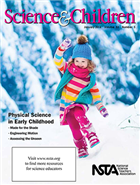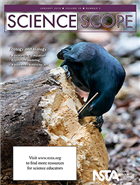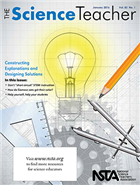Ideas and information from NSTA's January K-12 journals
By Mary Bigelow
Posted on 2016-01-26
All three journals this month include the article Addressing Three Common Myths About the Next Generation Science Standards – another must-read article that applies to all grade levels and science subjects.
 Science and Children – Physical Science in Early Childhood
Science and Children – Physical Science in Early Childhood
Our youngest students are inquisitive about the physical world – gravity, matter, weather, motion, the solar system, sound, light… Here are suggestions for building on their natural curiosity and their questions about the world around them.
- Made for the Shade has a 5E lesson in which students create shelters to protect “lizards” from harmful UV radiation.
- How We Know What We Know uses cars and ramps to challenge what evidence students can gather to support their conclusions.
- Engineering Motion includes suggestions for students to make and test car models and communicate their results.
- Assessing the Unseen combines students’ interests in music and literature
- Seeing the Solar System Through Two Perspectives connects
- Teaching Through Trade Books: You Light Up My Life has two lessons to investigate materials that are translucent, transparent, opaque, and reflective.
- The Early Years: Blowing Bubbles can be an introduction to many science concepts and practices.
- Formative Assessment Probes: Uncovering Students’ Concept of Matter helps you to find out what students do (or do not) know about this concept.
- Engineering Encounters: A House for Chase the Dog has a 5E lesson in which students study the characteristics of materials in order to protect a pet from the weather.
For more on the content that provides a context for these projects and strategies see the SciLinks websites for Colors, Forces and Motions, Light, Matter, Pinhole Images, Properties of Matter, Reflection, Reptiles, Sound, States of Matter, UV Index, Vibration.
Continue for Science Scope and The Science Teacher.
Science Scope – Ecology and Biology
- A Biomedical Engineering Twist to Science
 Fairs has suggestions for an engineering fair as an alternative to traditional science fairs. There are ideas for both competitive and in-class fairs with a focus on medical problems/inventions.
Fairs has suggestions for an engineering fair as an alternative to traditional science fairs. There are ideas for both competitive and in-class fairs with a focus on medical problems/inventions. - Modeling Ecosystems has a lesson for going beyond models as replicates of objects (e.g., the cell) to the use of models to explain and predict phenomena
- Outbreak! Cells, Pathogens, and Disease uses a 5E lesson to help students explore the science behind global outbreaks of diseases.
- Eco-Choices: Understanding the Complex Consequences of Local Decisions describes a simulation that could be used as an introduction or an assessment. Students explore how their decisions affect an ecosystem and design solutions to real-life problems.
- Tried and True: Bird-Brained Foraging: Learn to Eat Like a Crow has another approach to connecting living things to their food chains.
- Engaging Students With Dynamic Models: Peruvian Food Chain Jenga shows how a common game can be repurposed into a model, in this case a model of marine-based food chains.
For more on the content that provides a context for these projects and strategies see the SciLinks websites for Bacteria, Biomedical Engineer, Cell Features, Cell Growth, Disease, Ecosystems, Food Webs, Habitats and Niches, Marine Ecosystems, Microbes, Modern Epidemics, Pathogens, Watersheds.
The Career of the Month: Agricultural Engineer in The Science Teacher could also fit with this month’s theme.
 The Science Teacher – Constructing Explanations and Designing Solutions
The Science Teacher – Constructing Explanations and Designing Solutions
“Science is all about asking questions and constructing explanations, while engineering focuses on defining problems and designing solutions. I think of science as the quest for timeless truths and engineering as the search for design solutions rooted in a particular time and situation… Science and engineering work hand in hand to understand and address major challenges confronting our world…” TST Field Editor Steve Metz
- Don’t “Short Circuit” Stem Instruction has ideas for using electric circuits to learn about science and engineering practices.
- How Do Siamese Cats Get Their Color? asks students to connect genes, proteins, and traits to explain and model the phenomenon.
- Salamander Saver illustrates how students can participate in design projects with real-world applications
- Assessment as Learning explores the idea of assessment as learning, where students learn, collaborate, and self-correct during the assessment, using the separation of mixtures as a context.
- Science 2.0: Do I Need a Robot? describes connecting with students via a “telepresence.”
- The Green Room: Hurricanes and Humans provides timely information on severe storms in an El Niño year.
- Idea Bank: Secrets of the “Sunspots” address misconceptions about sunlight and eclipses, using pinhole cameras and geometry.
For more on the content that provides a context for these projects and strategies see the SciLinks websites for Chromatography, Distillation, Dominant and Recessive Traits, Eclipses, El Niño, Electric Circuits, Genetics, Hurricanes, Lakes and Ponds, Pinhole Images, Proteins, Protein/ Enzymes, Robots, Salamanders.
Check out the Teach Engineering site for more lessons that integrate science and engineering in real-life scenarios.
Disclaimer: The views expressed in this blog post are those of the author(s) and do not necessarily reflect the official position of the National Science Teaching Association (NSTA).


